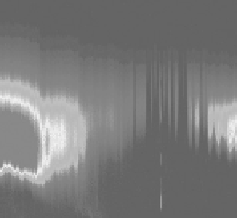Geoscience Reference
In-Depth Information
0
60
60
30
30
0
0
30
2
30
2
60
2
60
2
0
3 5 10 15 20
Occurrence rate (%)
Figure 6.27b
Global distribution of the occurrence rate of the MEFs observed by the
DE-2 satellite between 250 and 900 km altitude. [After Kelley et al. (2002). Reproduced
with permission of Elsevier Press.]
10
25
6300 Emission (Feb 20/21, 1999)
Pedersen conductivity (Feb 20/21, 1999)
3
450
30
450
2.5
400
25
400
2
350
20
350
1.5
300
15
300
1
250
10
250
0.5
200
5
200
150
0
150
0
20
21
22
23
24
01
20
21
22
23
24
01
LT (hrs)
LT (hrs)
Figure 6.28a
A comparison of the modeled 630.0 nm airglow emission line (left) and
the calculated Pedersen conductivity (right) for February 20-21, 1999. [After Kelley et al.
(2000c). Reproduced with permission of the American Geophysical Union.] See Color
Plate 17.
raising the layer, these regions are also observed to be depleted of plasma (Kelley
et al., 2002). Once formed, the low-TEC regions propagate toward the southwest
and can last many hours. Figure 6.28b shows simultaneous TEC and airglow
observations (Saito et al., 2001).
Airglow observations have been made in both hemispheres during a mesoscale
TID event (Otsuka et al., 2004). Figure 6.29 shows the structures in geographic
coordinates. But when the southern image is mapped along the magnetic field to
































































































































































































































































































Search WWH ::

Custom Search